Watermelon
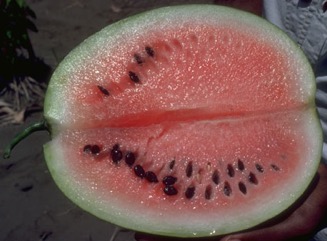
A tropical plant. They grow best on the coast in the tropics but will grow up to about 1,700 m altitude. They will not stand water-logging and do well on sandy soils. Plants are frost sensitive. Seed will not germinate below 21°C. Temperatures between 24-30°C are suitable. It can grow in arid places. Fruit are sweeter in arid warm areas. It suits hardiness zones 10-12.
Also known as:
Agushi, Anowotere, Atsetsea, Bara, Battikh, Beteka, Bittekh, Blass, Bostan, Bvani, Chimwamaji, Chimwela, Cimango, Dagita, Deri, Dole dodosine, Dua hau, Egusi, Goussi-gaga, Guna, Habu, Ibece, Ibotolo, Ihele, Intshabotyi, Itikitiki, Kalambojo, Kamandiki, Kankana, Karaa, Kemikaii, Kgengwe, Khakha, Komadu, Labu ayer, Lehapu, Lerotse, Litichiti, Majoda, Makakabane, Makatendry, Mak po, Matao, Mbika ntetu, Melancia, Meleni, Melon de agua, Mendikai, Mereni, Mubvembe, muShamba, Munwiwa, muVise, Narracuene, Nendikai, Ogili, Oru, 'Owllok, Pakwan, Peni-komadu, Pitcha, Samangka, Sandia, Sandiya, Sania, Semongka, Sihka, Tarabuja, Tarbuj, Tarbuz, Tarmuj, Te meren, Tembikai, Temikai, Thaisim hagong, Thoomo, Tinacanti, Tjoto, Voasavy, Vwende, Watesan, Watre, Wedamelon
Synonyms
- Citrullus edulis Spach.
- Citrullus mucospermus (Fursa) Fursa
- Citrullus vulgaris Schrad.
- Colocynthis citrullus (L.) O. Ktze.
- Cucumis citrullus (L.) Ser.
- Cucurbita citrullus L.
- Momordica lanata Thunb.
Edible Portion
- Fruit, Seeds, Leaves, Vegetable
Where does Watermelon grow?
Found in: Africa, Amazon, Angola, Argentina, Aruba, Asia, Australia, Austria, Azerbaijan, Bangladesh, Benin, Bolivia, Botswana, Bougainville, Brazil, Burkina Faso, Burundi, Cabinda, Cambodia, Cameroon, Cape Verde, Caucasus, Central Africa, Central African Republic, CAR, Central America, Chad, China, Congo DR, Cook Islands, Costa Rica, Côte d'Ivoire, Cuba, Dominican Republic, East Africa, East Timor, Easter Island, Ecuador, Egypt, Equatorial-Guinea, Eritrea, Eswatini, Ethiopia, Fiji, FSM, Gabon, Gambia, Georgia, Ghana, Greece, Grenada, Guam, Guiana, Guianas, Guinea, Guinée, Guinea-Bissau, Guyana, Haiti, Hawaii, Himalayas, India, Indochina, Indonesia, Iran, Iraq, Italy, Ivory Coast, Jamaica, Japan, Kenya, Kiribati, Korea, Kyrgyzstan, Laos, Lesotho, Liberia, Libya, Macedonia, Madagascar, Malawi, Malaysia, Maldives, Mali, Malta, Marquesas, Mauritania, Mauritius, Mediterranean, Mexico, Mozambique, Myanmar, Namibia, Nauru, Nepal, New Zealand, Nicaragua, Niger, Nigeria, North Africa, North America, Northeastern India, Pacific, Pakistan, Papua New Guinea, PNG, Paraguay, Peru, Philippines, Pohnpei, Puerto Rico, Rotuma, Russia, Samoa, Sao Tome and Principe, Saudi Arabia, SE Asia, Senegal, Serbia, Seychelles, Sierra Leone, Solomon Islands, Somalia, South Africa, Southern Africa, South America, South Sudan, Spain, Sri Lanka, St. Vincent and Grenadines, Sudan, Suriname, Swaziland, Switzerland, Syria, Tanzania, Thailand, Timor-Leste, Togo, Tokelau, Tonga, Tunisia, Turkey, Tuvalu, Uganda, Ukraine, United States, Uzbekistan, Vanuatu, Venezuela, Vietnam, West Africa, West Indies, Yugoslavia, Zambia, Zimbabwe
Notes: There are 3 Citrullus species. The fruit are mostly water with little food value or taste. Some kinds are being selected for seeds for oil. The seed oil is nutritious.
Status: It is a commercially cultivated vegetable. The seeds are a popular food in China. Common and popular in lowland areas of Papua New Guinea.
Growing Watermelon
Cultivation: Plants are grown from seed. They are suitable mainly for the dry season. A spacing of 1.5 to 2 m is suitable. They grow easily from seed. They do best when fully exposed to the sun. Seed can be dried and stored. If too much vegetative growth occurs picking out the tip to produce side branches with more fruit.
Edible Uses: The fruit is eaten raw when ripe. Small unripe fruit can be cooked as a vegetable. Seeds are also eaten. They are dried, soaked in salt water then roasted. Oil is extracted from the seeds. The seeds are ground and made into bread. Occasionally very young leaves are eaten. The skin is sometimes candied in vinegar then eaten with fish. The syrup from the fruit can be used in jams and cakes.
Production: Plants grow quickly. Harvesting commences after 4-5 months. The main fruit season is November to January. The ripeness can be picked by tapping the fruit to get a dull sound, the part of the fruit on the ground changes from green to light yellow and the tendril near the base of the fruit becomes dry. Fruit yield can be 45-60 tons per hectare. There can be 4-6 fruit on each plant.
Nutrition Info
per 100g edible portion| Edible Part | Energy (kcal) | Protein (g) | Iron (mg) | Vitamin A (ug) | Vitamin c (mg) | Zinc (mg) | % Water |
|---|---|---|---|---|---|---|---|
| Seeds | 514 | 40 | 5.6 | - | - | - | 10 |
| Fruit | 36 | 0.6 | 0.2 | - | - | - | 90 |
Watermelon Photos

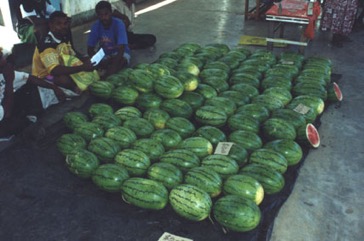
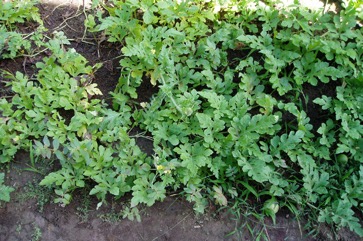
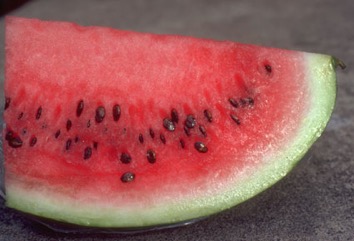
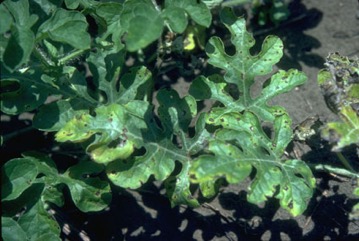
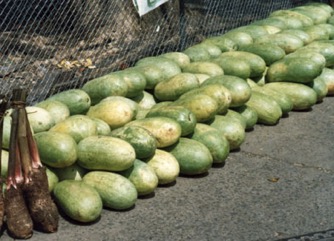
References
Achigan-Dako, E, et al (Eds), 2009, Catalogue of Traditional Vegetables in Benin. International Foundation for Science.
Addis, G., Asfaw, Z & Woldu, Z., 2013, Ethnobotany of Wild and Semi-wild Edible Plants of Konso Ethnic Community, South Ethiopia. Ethnobotany Research and Applications. 11:121-141
Ambasta, S.P. (Ed.), 2000, The Useful Plants of India. CSIR India. p 127 (As Citrullus vulgaris)
Anderson, E. F., 1993, Plants and people of the Golden Triangle. Dioscorides Press. p 206
Arnold, T.H., Wells, M.J. & Wehmeyer, A.S., Khoisan food plants: taxa with potential for future economic exploitation, in Wickens, G.E., Goodin, J.R., and Field, D.V.,(Eds.) 1985, Plants for Arid Lands. Unwin Hyman, London, p 73
Barrau, J., 1976, Subsistence Agriculture in Melanesia. Bernice P. Bishop Museu, Bulletin 219 Honolulu Hawaii. Kraus reprint. p 53 (As Citrullus vulgaris)
BHANDARI,
Beckstrom-Sternberg, Stephen M., and James A. Duke. "The Foodplant Database." http://probe.nalusda.gov:8300/cgi-bin/browse/foodplantdb.(ACEDB version 4.0 - data version July 1994)
Bennett, B. C., 1990, Useful Plants of Amazonian Ecuador. US Agency for International Development. Fifth Progress Report. New York Botanical Gardens. p 40
Bianchini, F., Corbetta, F., and Pistoia, M., 1975, Fruits of the Earth. Cassell. p 138
Brouk, B., 1975, Plants Consumed by Man. Academic Press, London. p 203
Burkill, H. M., 1985, The useful plants of west tropical Africa, Vol. 1. Kew.
Burkill, I.H., 1966, A Dictionary of the Economic Products of the Malay Peninsula. Ministry of Agriculture and Cooperatives, Kuala Lumpur, Malaysia. Vol 1 (A-H) p 567 (As Citrullus vulgaris)
Bussman, R. W., et al, 2016, A comparative ethnobotany of Khevsureti, Samtskhe-Javakheti, Tusheti, Svaneti, and Racha-Lechkhumi, Republic of Georgia (Sakartvelo), Caucasus. Journal of Ethnobiology and Ethnomedicine (2016) 12:4
Bussman, R. W. et al, 2017, Ethnobotany of Samtskhe-Javakheti, Sakartvelo (Republic of Georgia), Caucasus. Indian Journal of Traditional Knowledge Vol. 16(1) pp 7-24
Cat. sem. spor. hort. bot. Univ. Imp. Tokyo 30, no. 854. 1916 (l.c. 38. 1920)
Cheifetz, A., (ed), 1999, 500 popular vegetables, herbs, fruits and nuts for Australian Gardeners. Random House p 179
Chin, H.F., & Yong, H.S., 1996, Malaysian Fruits in Colour. Tropical press, Kuala Lumpur p 24
Cobley, L.S. (rev. Steele, W.M.) 2nd Ed., 1976, An Introduction to the Botany of Tropical Crops. Longmans. p 139
CRÉAC'H, (As Citrullus vulgaris)
Cundall, P., (ed.), 2004, Gardening Australia: flora: the gardener's bible. ABC Books. p 382
Dansi, A., et al, 2008, Traditional leafy vegetables and their use in the Benin Republic. Genet Resour Crop Evol (2008) 55:1239–1256
Dansi, A., et al, 2012, Diversity of the Neglected and Underutilized Crop Species of Importance in Benin. The Scientific World Journal. Volume 2012, Article ID 932947, 19 pages
Ekman Herbarium records Haiti (As Citrullus vulgaris)
Epenhuijsen C.W. van., 1974, Growing Native vegetables in Nigeria. FAO Rome, p 53
Facciola, S., 1998, Cornucopia 2: a Source Book of Edible Plants. Kampong Publications, p 84
FAO, 1988, Traditional Food Plants, FAO Food and Nutrition Paper 42. FAO Rome p 186
Farooq, S., et al, 2012, Ethnobotanical Studies of the Flora of Tehsil Birmal in South Waziristan Agency, Pakistan. Pak. J. Weed Sci. Res. 18(3): 277-291 (As Citrullus vulgaris)
Flora of Australia, Volume 8, Lecythidales to Batales, Australian Government Publishing Service, Canberra (1982) p 173
Flowerdew, B., 2000, Complete Fruit Book. Kyle Cathie Ltd., London. p 120
Fowler, D. G., 2007, Zambian Plants: Their Vernacular Names and Uses. Kew. p 22
Fox, F. W. & Young, M. E. N., 1982, Food from the Veld. Delta Books. p 165
French, B.R., 1986, Food Plants of Papua New Guinea, A Compendium. Asia Pacific Science Foundation p 209
French, B.R., 2010, Food Plants of Solomon Islands. A Compendium. Food Plants International Inc. p 208
Furusawa, T., et al, 2014, Interaction between forest biodiversity and people's used of forest resources in Roviana, Solomon Islands: implications for biocultural conservation under socioeconomic changes. Journal of Ethnobiology and Ethnomedicine, 10:10
Grubben, G. J. H. and Denton, O. A. (eds), 2004, Plant Resources of Tropical Africa 2. Vegetables. PROTA, Wageningen, Netherlands. p 185
GUPTA & KANODIA,
Hadfield, J., 2001, The A-Z of Vegetable Gardening in South Africa. Struik p 132
Harris, F. M. A. and Mohammed, S., 2003, Relying on Nature: Wild Foods in Northern Nigeria. Ambio Vol. 32 No. 1. p 25-30
Hedrick, U.P., 1919, (Ed.), Sturtevant's edible plants of the world. p 195
Hunter, J.T., 2017, Is there a relationship between contemporary high Aboriginal plant resource locations and mapped vegetation communities? Cunninghamia 17:27-34. The Royal Botanic Garden Sydney. ISSN 2200 - 405X
Hussey, B.M.J., Keighery, G.J., Cousens, R.D., Dodd, J., Lloyd, S.G., 1997, Western Weeds. A guide to the weeds of Western Australia. Plant Protection Society of Western Australia. p 140
Hu, Shiu-ying, 2005, Food Plants of China. The Chinese University Press. p 694 (As Citrullus battich)
INFOODS:FAO/INFOODS Databases
John, L., & Stevenson, V., 1979, The Complete Book of Fruit. Angus & Robertson p 278
Jardin, C., 1970, List of Foods Used In Africa, FAO Nutrition Information Document Series No 2.p 41, 67, 128
Kays, S. J., and Dias, J. C. S., 1995, Common Names of Commercially Cultivated Vegetables of the World in 15 languages. Economic Botany, Vol. 49, No. 2, pp. 115-152
Kenneally, K.E., Edinger, D. C., and Willing T., 1996, Broome and Beyond, Plants and People of the Dampier Peninsula, Kimberley, Western Australia. Department of Conservation and Land Management. p 95
Khan, D. & Shaukat, S.S., 2006, The Fruits of Pakistan: Diversity, Distribution, Trends of Production and Use. Int. J. Biol. Biotech., 3(3):463-499
Kiple, K.F. & Ornelas, K.C., (eds), 2000, The Cambridge World History of Food. CUP p 1877
Latham, P., 2004, Useful Plants of Bas-Congo province. Salvation Army & DFID p 78
Lazarides, M. & Hince, B., 1993, Handbook of Economic Plants of Australia, CSIRO. p 60 (Also as Citrullus lanatus var. lanatus)
Leger, S., 1997, A Description of Today's Use of Plants in West Bushmanland (Namibia). German Development Service. PO Box 220035, 14061 Berlin, Germany. http://www.sigridleger.de/book/
Lembaga Biologi Nasional, 1977, Buah-Buahan, Balai Pustaka, Jakarta. p 120
Long, C., 2005, Swaziland's Flora - siSwati names and Uses http://www.sntc.org.sz/flora/
Lorenzi, H., Bacher, L., Lacerda, M. & Sartori, S., 2006, Brazilian Fruits & Cultivated Exotics. Sao Paulo, Instituto Plantarum de Estuados da Flora Ltda. p 382
Lulekal, E., et al, 2011, Wild edible plants in Ethiopia: a review on their potential to combat food insecurity. Afrika Focus - Vol. 24, No 2. pp 71-121
Lyle, S., 2006, Discovering fruit and nuts. Land Links. p 125
Macmillan, H.F. (Revised Barlow, H.S., et al) 1991, Tropical Planting and Gardening. Sixth edition. Malayan Nature Society. Kuala Lumpur. p 273
Manandhar, N.P., 2002, Plants and People of Nepal. Timber Press. Portland, Oregon. p 155
Martin, M.A., 1971, Introduction L'Ethnobotanique du Cambodge. Centre National de la Recherche Scientifique. Paris.
Martin, F.W. & Ruberte, R.M., 1979, Edible Leaves of the Tropics. Antillian College Press, Mayaguez, Puerto Rico. p 189 (As Citrullus vulgaris)
Maundu, P. et al, 1999, Traditional Food Plants of Kenya. National Museum of Kenya. 288p
McKerney, M. & White, H., 2011, Bush Tucker, Boomerangs & Bandages. Border River-Gwyder Catchment Management Authority p 195
Medhi, P. & Borthakur, S. K., 2012, Phytoresources from North Cachur Hills of Assam -3: Edible plants sold at Hflong market. Indian Journal or Natural Products and Resources. 3(1) pp 84-109
Menninger, E.A., 1977, Edible Nuts of the World. Horticultural Books. Florida p 105
Morley, B.D., & Toelken, H.R., (Eds), 1983, Flowering Plants in Australia. Rigby. p 101
Mutie, F. G., 2020, Conservation of Wild Food Plants and Their Potential for Combatting Food Insecurity in Kenya as Exemplified by the Drylands of Kitui County. Plants 2020, 9, 1017
Norrington, L., & Campbell, C., 2001, Tropical Food Gardens. Bloomings Books. p 49
Ochse, J.J. et al, 1931, Vegetables of the Dutch East Indies. Asher reprint. p 185 (As Citrullus vulgaris)
Omawale, 1973, Guyana's edible plants. Guyana University, Georgetown p 53 (As Citrullus vulgaris)
Owen, S., 1993, Indonesian Food and Cookery, INDIRA reprints. p 83
Paczkowska, G. & Chapman, A.R., 2000, The Western Australian Flora. A Descriptive Catalogue. Western Australian Herbarium. p 220
Paz, F. S., et al, 2021, Edible Fruit Plant Species in the Amazon Forest Rely Mostly on Bees and Beetles as Pollinators. Journal of Economic Entomology, XX(XX), 2021, 1–13
Peters, C. R., O'Brien, E. M., and Drummond, R.B., 1992, Edible Wild plants of Sub-saharan Africa. Kew. p 98
Pham-Hoang Ho, 1999, An Illustrated Flora of Vietnam. Nha Xuat Ban Tre. p 569
Phon, P., 2000, Plants used in Cambodia. © Pauline Dy Phon, Phnom Penh, Cambodia. p 157
Pieroni, A. et al, 2013, One century later: the folk botanical knowledge of the last remaining Albanians of the upper Reka Valley, Mount Korab, Western Macedonia. Journal of Ethnobiology and Ethnomedicine. 9:22
Plants for a Future database, The Field, Penpol, Lostwithiel, Cornwall, PL22 0NG, UK. http://www.scs.leeds.ac.uk/pfaf/
Plants of Haiti Smithsonian Institute http://botany.si.edu/antilles/West Indies
Purseglove, J.W., 1968, Tropical Crops Dicotyledons, Longmans. p 102
Rajapaksha, U., 1998, Traditional Food Plants in Sri Lanka. HARTI, Sri Lanka. p 139 (As Colocynthis citrullus)
Recher, P, 2001, Fruit Spirit Botanical Gardens Plant Index. www.nrg.com.au/~recher/ seedlist.html p 1
Rashid, H. E., 1977, Geography of Bangladesh. Westview. p 346 (As Citrullus vulgaris)
Royal Botanic Gardens, Kew (1999). Survey of Economic Plants for Arid and Semi-Arid Lands (SEPASAL) database. Published on the Internet; http://www.rbgkew.org.uk/ceb/sepasal/internet [Accessed 15th April 2011]
Ruiters-Welcome, A. K., 2019, Food plants of southern Africa. Ph.D. thesis. Univ. of Johannesburg p 48
SAXENA,
Segnon, A. C. and Achigan-Dako, E. G., 2014, Comparative analysis of diversity and utilization of edible plants in arid and semi-arid areas in Benin. Journal of Ethnobiology and Ethnomedicine. 10:80 (As Citrullus mucusospermus)
Segura, S., et al, 2018, The edible fruit species in Mexico. Genet Resour Crop Evol (2018) 65:1767–1793
SHANKARNARAYAN & SAXENA,
Sharma, B.B., 2005, Growing fruits and vegetables. Publications Division. Ministry of Information and broadcasting. India. p 185
Shava, S., et al, 2009, Traditional food crops as a source of community resilience in Zimbabwe. International Journal of the African Renaissance 4(1)
Siemonsma, J. S. and Piluek, K. (Eds), 1994, Plant Resources of South-East Asia No. 8 Vegetables. Prosea Foundation, Bogor, Indonesia, p 144
Stanley, T. D. & Ross, E. M., 1986, Flora of south-eastern Queensland Volume 2. Queensland Government p 113
Staples, G.W. and Herbst, D.R., 2005, A tropical Garden Flora. Bishop Museum Press, Honolulu, Hawaii. p 264
Sujanapal, P., & Sankaran, K. V., 2016, Common Plants of Maldives. FAO & Kerala FRI, p 80
Tate, D., 1999, Tropical Fruit. Archipelago Press. Singapore. p 44
Thaman, R.R., 1976, The Tongan Agricultural System, University of the South Pacific, Suva, Fiji. p 388 (As Citrullus vulgaris)
Thaman, R. R., 1987, Plants of Kiribati: A listing and analysis of vernacular names. Atoll Research Bulletin No. 296
Thaman, R. R, 2016, The flora of Tuvalu. Atoll Research Bulletin No. 611. Smithsonian Institute p 80
Tindall, H.D., & Williams, J.T., 1977, Tropical Vegetables and their Genetic Resources, International Board for Plant Genetic Resources, Rome, p 40
Tindall, H.D., 1983, Vegetables in the tropics. Macmillan p. 150
Tredgold, M.H., 1986, Food Plants of Zimbabwe. Mambo Press. p 3
USDA, ARS, National Genetic Resources Program. Germplasm Resources Information Network - (GRIN). [Online Database] National Germplasm Resources Laboratory, Beltsville, Maryland. Available: www.ars-grin.gov/cgi-bin/npgs/html/econ.pl (10 April 2000) (As Citrullus lanatus var. lanatus)
Vael, L., 2015, Ethnobotanical study of the plant use in the natural landscape of two mestizo communities in the Ucayali region of the Peruvian Amazon. Universiteit Gent.
Valder, P., 1999, The Garden Plants of China. Florilegium. p 188
van der Vossen, H.A.M. & Denton, O.A. & El Tahir, I.M., 2004. Citrullus lanatus (Thunb.) Matsum. & Nakai. [Internet] Record from Protabase. Grubben, G.J.H. & Denton, O.A. (Editors). PROTA (Plant Resources of Tropical Africa), Wageningen, Netherlands. < http://database.prota.org/search.htm>. Accessed 14 October 2009.
van Wyk, B., 2005, Food Plants of the World. An illustrated guide. Timber press. p 136
van Wyk, B-E., 2011, The potential of South African plants in the development of new food and beverage products. South African Journal of Botany 77 (2011) 857–868
Vasquez, R. and Gentry, A. H., 1989, Use and Misuse of Forest-harvested Fruits in the Iquitos Area. Conservation Biology 3(4): 350f
Walters, T. W., 1989, Historical Overview on Domesticated Plants in China with Special Emphasis on the Cucurbitaceae. Economic Botany 43(3): 297-313
Walter, A. & Lebot, V., 2007, Gardens of Oceania. ACIAR Monograph No. 122. p 183
WEBB,
Wechter, W. P., et al, 2008, Gene expression in developing watermelon fruit. BMC Genomics 9:275
Wehmeyer, A. S, 1986, Edible Wild Plants of Southern Africa. Data on the Nutrient Contents of over 300 species
Wheeler, J.R.(ed.), 1992, Flora of the Kimberley Region. CALM, Western Australian Herbarium, p 247 (As Citrullus lanatus var. lanatus)
Whitaker, T.W., & Bemis, W.P., 1979, Cucurbits, in Simmonds N.W.,(ed), Crop Plant Evolution. Longmans. London. p 64
Wickens, G.E., 1995, Edible Nuts. FAO Non-wood forest products. FAO, Rome. p 119
Wild edible plants of Himachal Pradesh
Williamson, J., 2005, Useful Plants of Malawi. 3rd. Edition. Mdadzi Book Trust. p 65
World Checklist of Useful Plant Species 2020. Royal Botanic Gardens, Kew
www.zimbabweflora.co.zw 2011
Zambrana, P, et al, 2017, Traditional knowledge hiding in plain sight – twenty-first century ethnobotany of the Chácobo in Beni, Bolivia. Journal of Ethnobiology and Ethnomedicine (2017) 13:57
Zizka, G., 1991, Flowering Plants of Easter Island. Palmarum Hortus Francofurtensis